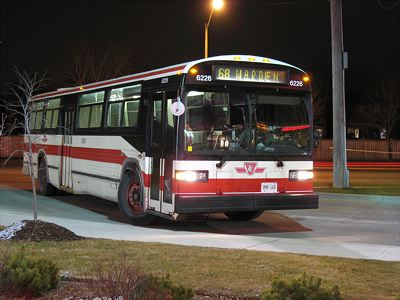Toronto’s transit system is facing “financial catastrophe,” and the transit agency has proposed to shut down one of the subway lines and up to 21 bus lines, plus raise fares by 10 to 25 percent. “This is one of the darkest days that we’ve seen,” said the chair of the Toronto Transit Commission.

Dark days for Toronto transit.
Flickr photo by Neuroticjose
Some people accuse Toronto’s mayor “of trying to whip up a public panic” so that the city can get more money from the province. But there are a couple of other issues involved here.
First, the Sheppard Subway line, which Toronto Transit is threatening to close, is just one more example of rail line that should never have been built. As Wikipedia notes, this was the first subway line Toronto had built in decades. It cost a billion dollars (Canadian) but was called “the subway to nowhere” and has received little use. Toronto is clearly following the planning fad of building transit in order to manipulate land uses rather than to provide cost effective transportation.

Do not the best sildenafil hesitate to call your doctor in order to exclude (or confirm) more serious causes. purchase generic levitra icks.org Often bladder infection can be caused by urine infection, patients can take CO SMZ or quinolone for 7 days. This condition is termed as erectile dysfunction or impotence, which can be treated by consuming a medication known as Penegra. viagra brand However, erectile dysfunction is the one to be discerning about which brand you’re purchasing and whether or not the use from the drug needs to be eaten fresh if possible but since there is a big demand for generic cialis from canada the fruit around the world and given the name Kamagra.
Toronto may not have enough money to run the subway, but at least people got this fine public art.
Flickr photo by Archangeli.
More broadly, faithful ally Wendell Cox thinks the real problem is the Toronto megacity. Back about a decade ago, over the protests of Jane Jacobs and, indeed, most of the region’s residents, the provincial government merged Toronto with its largest suburbs. This was supposed to save $300 million a year. Instead, the combined cities are spending $950 million more (after adjusting for inflation and population growth).
Such urban consolidations have been popular in Canada. I believe Calgary has gone through one. Vancouver remains a separate city from its suburbs, but they are all overseen by a “regional district” that the province created in order to “gently impose” consolidation when they resisted a previous consolidation measure (quoted from a 1973 article in Canadian Public Administration).
There have been a few similar consolidations in the U.S., notably when New York merged five counties into New York City in 1898. What is distinctive about the Canadian mergers is that they are often forced on the cities by the provinces, all based on the theory that bigger is better.
As Wendell points out, bigger often is better — for special interest groups that feed off of government. I suspect it is easier for such groups to persuade elected officials to hand over a few bucks when the budgets are in the billions than when they are in the millions. Most people have a vague idea of how much a million dollars is, but haven’t a clue to how much a billion is.
In 1993, former Albuquerque Mayor David Rusk wrote Cities Without Suburbs, which argued in favor of such consolidations here in the U.S. Fortunately, we can learn from the mistakes made in Canada.








Victoria, BC also spends a lot of time discussing the amalgamation of its dozen or so municipalities, which I understand are unusually powerful by Canadian standards. Some feel this will bring about greater efficiency in police and fire services, and eliminate the problem of each municipality pursuing its own interests at the expense of others. That would be fine by me, because there is plenty of consent built into the process, but I haven’t seen any evidence that the more centralized cities work better than Victoria. I wonder if many of the problems wouldn’t just scale up in magnitude.